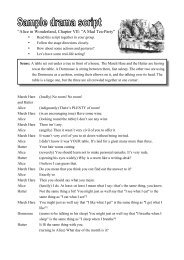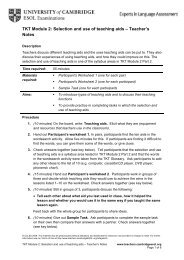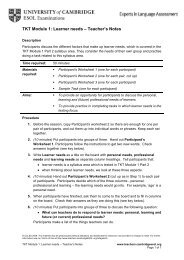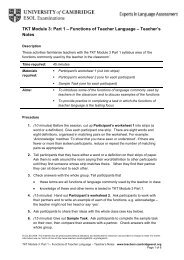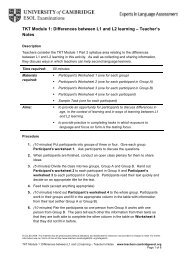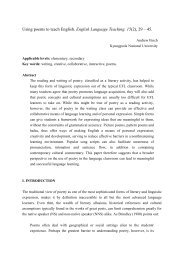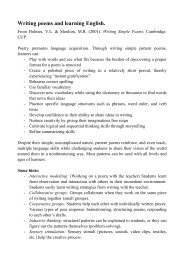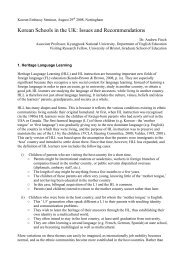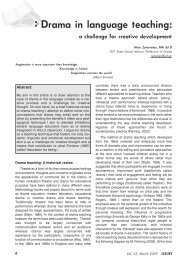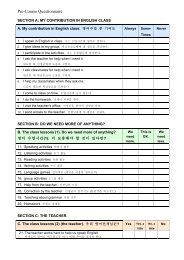Portfolios and Projects: The Understanding Crisis 1 ... - Finchpark
Portfolios and Projects: The Understanding Crisis 1 ... - Finchpark
Portfolios and Projects: The Understanding Crisis 1 ... - Finchpark
You also want an ePaper? Increase the reach of your titles
YUMPU automatically turns print PDFs into web optimized ePapers that Google loves.
user is able to combine them in new <strong>and</strong> appropriate ways to meet the linguisticdem<strong>and</strong>s of the situation in which he wishes to use the language. (Morrow1979:145)Stevick (1976:225) identifies 4 forms of alienation which result from such an approach,<strong>and</strong> which have resulted in the failure in modern language teaching: i) alienation of thelearners from the material; ii) alienation of the learners from themselves; iii) alienation ofthe learners from the class; <strong>and</strong> iv) alienation of the learners from the teacher. <strong>The</strong>sealienations are indicative of an impersonal education system which valued intellect (asdefined by that system) over emotion, <strong>and</strong> behavioristic learning over moral responsibility– characteristics that were justified by policy-makers eager for literate factory workers tofuel a growing industrial base for their economy, but which are no longer justifiable in anera of rapidly changing technology, communications <strong>and</strong> employment. Changes whichoccurred in the twentieth century in terms of social sciences, psychology, philosophy, <strong>and</strong>political science, attest to a society in which learning <strong>and</strong> underst<strong>and</strong>ing metaskills(problem-solving, critical thinking, etc.) are more important than knowledge, <strong>and</strong> in whichvarious kinds of social awareness (minority rights, the status of women, rights of patients)have helped to make "quality of life" the new marker of social progress Holec (1980:1):From the idea of man ‘product of his society', one moves to the idea of man‘producer of his society'. (Janne ND[2], cited in Holec 1980:2)In second language learning, this humanistic trend (i.e. towards improving the quality oflife of the learner) has driven a general educational concern to help students become moreindependent in how they think, learn <strong>and</strong> behave (cf. Boud 1988; Hammond & Collins1991), with knowledge being constructed by individuals rather than transmitted from oneperson to another, <strong>and</strong> with learning occurring "within specific contexts, mainly as a resultof social interactions" (Williams & Burden, 1997:46). In such an approach, a number ofunderlying themes concerning human nature <strong>and</strong> human learning emerge:1. high-level health <strong>and</strong> well-being2. the whole person3. the human motivation towards self-realization4. change <strong>and</strong> development5. education as a life-long process6. respect for an individual's subjective experience7. self-empowerment. (Underhill: 1989:251)
<strong>The</strong>se themes can be found in the humanistic view of learning, propounded half a centuryago by Rogers (1951):1. Learning is the process of changing behavior in a positive direction.2. Learning is an experience that occurs inside the learner <strong>and</strong> is activated by thelearner.3. Learning is the discovery of the personal meaning <strong>and</strong> relevance of ideas.4. Learning (behavioral change) is a consequence of experience.5. Learning is a cooperative <strong>and</strong> collaborative process.6. Learning is an evolutionary process.7. Learning is sometimes a painful process.8. One of the richest resources for learning is the learner himself.9. <strong>The</strong> process of learning is emotional as well as intellectual.10. Learning fuses work <strong>and</strong> play.11. Learning is a ‘religious' experience.12. <strong>The</strong> learner is a free <strong>and</strong> responsible agent.13. <strong>The</strong> processes of problem solving <strong>and</strong> learning are highly unique <strong>and</strong> individual.14. Teaching is learning. (Rogers 1951:115)1.2 Old ideas in a new bottle?It is significant to note at this point that, having rejected propositional teachingmethodologies as ineffective <strong>and</strong> unfounded (though teacher-training institutions continueto advocate the "presentation-practice-performance" method, despite its "descredited,meaning-impoverished" status [White 1988]), educational theory is addressing theproblems associated with an under-performing education system by revisiting ideas thatcommentators such as Rogers, Dewey, Bruner, Frière <strong>and</strong> Vygotsky were expounding evenbefore Applied Linguistics set out on its love affair with behaviorism. Indeed, a holisticview of education, which can be traced back to Aristotle, Plato, <strong>and</strong> early orientalphilosophers, represents a return to basic principles, rather than simply another fashionabletrend. In Korea, the ideal of hongik-ingan ("contributing to the overall benefit ofhumankind") has always been at the heart of Korean education, <strong>and</strong> the well-educatedperson (the goal of Korean education) defined in official curriculum-policy documents(Korean Ministry of Education website, 2001) in terms of holistic development, creativeability based on knowledge <strong>and</strong> skills, <strong>and</strong> ethical contribution to the community. Such anemphasis must surely be given utmost urgency in these times of natural <strong>and</strong> man-madedisasters (in affecting the climate, man is contributing to natural disasters, in addition to
providing his own catastrophes); times in which society, in its deification of monetary gain,has neglected to educate its citizens to be morally responsible; times in which an ethicalawareness must extend to every aspect of life.It is evident that a radical rethinking of education is necessary, since the present modelwould be unsatisfactory even if it were to suddenly become efficient. Imagine a society fullof A+ students as defined by traditional education (in Korean terms, this would correspondto a nation full of Seoul University graduates). Who would drive the trains, clean thestreets, grow the food, <strong>and</strong> deliver the newspapers? Such roles are integral to society, yettheir artisans are seen (<strong>and</strong> perceive themselves) as unsuccessful products of a system thatworships a knowledge-based version of intellectualism. Learners possessing practical skillsthat their teachers could not dream of are forced to attend institutions that tell them they areinept, <strong>and</strong> finally find themselves in "technical colleges", learning skills that are thelifeblood of the community, but which are not taught in "high-level" institutions. This is notto say that such learners should not receive education, but rather that the system itself needsto adapt by respecting the skills <strong>and</strong> abilities of all its participants.Language education is not exempt from this need to adapt, since it is typically utilitarian inits role, <strong>and</strong> also typically unsuccessful in producing learners who can be termedsuccessful, even within the narrow criterion of linguistic proficiency. <strong>The</strong> question "Howcan language be taught effectively?" must be exchanged for "How can the languageclassroom become an instrument of positive attitude change?", given that education of thewhole learner will develop learning skills <strong>and</strong> ethical qualities, <strong>and</strong> that effective languagelearning will occur as a result of increased social <strong>and</strong> personal awareness. In other words,how can language classrooms mirror changes in social development, <strong>and</strong> produce futurecitizens equipped to take on the challenges of a century in which the only constant will bechange? Legutke & Thomas (1991:7-10) pose a number of questions that are relevant atthis point, some of which are quoted here in full:Question 1: Is it possible <strong>and</strong> feasible to turn learners' classrooms into wholepersonevents, where body <strong>and</strong> soul, intellect <strong>and</strong> feeling, head, h<strong>and</strong> <strong>and</strong> heartconverge in action?Question 2: Can second-language (L2) learning be a satisfying activity in itself,in the here <strong>and</strong> now of the classroom? What do we need to do to exploit thepsycho-social reality of the L2 classroom <strong>and</strong> its immediate significance for bothteacher <strong>and</strong> learner? What adventures <strong>and</strong> challenges are possible under the veryconditions of L2 learning?"
Question 3: What needs to be done to regain some of this creative potential in theL2 classroom? Can we assume a similar potential for adult learners? Do we haveto consider individual <strong>and</strong> cultural differences?Question 4: What needs to be done to create situations <strong>and</strong> scenarios wherecommunication in the target language could be more meaningful? What are theroles of teacher, learners, topic <strong>and</strong> input in such scenarios? Could even inter<strong>and</strong>intra-student discourse be carried out in the target language?"Question 5: What needs to be done to develop in learners such a capacity forcritique? How can they become co-managers of their learning <strong>and</strong> participate intheir own teaching? How do we create the learning space so that learners cantake initiatives to pursue their own learning for their own benefit, <strong>and</strong> to discovertheir own learning styles? (Legutke & Thomas 1991:7-10)<strong>The</strong>se partly rhetorical questions highlight both the problem <strong>and</strong> a means of addressing it. Itis no longer defensible to use discrete-item testing of dubious constructs or to sampleperformance as a means of inferring underlying competence or abilities. Instead, the needto underst<strong>and</strong> performance itself <strong>and</strong> the processing (<strong>and</strong> affective) factors which influenceit, suggest reflective forms of assessment in instructionally-relevant classroom activities(communicative performance assessment, language portfolios <strong>and</strong> self-assessment), whichfocus on integration of instruction <strong>and</strong> assessment. In this two-way process, "the essentiallyinteractive nature of learning is extended to the process of assessment" (Williams & Burden1997:42), examining what learners can do with their language, through real-life languageuse tasks (cf. Weir 1998:9). In this light, Galyean (1977) suggests that the alienationsidentified by Stevick (above) can be reduced if classroom events include: i) learning in thehere <strong>and</strong> now; ii) student-offered material as the basis for learning <strong>and</strong> practising languagestructures; iii) interpersonal sharing; <strong>and</strong> iv) self-awareness <strong>and</strong> realization (Galyean 1977),<strong>and</strong> Williams & Burden (1997) propose ten basic propositions "crucial for languageteachers":1. <strong>The</strong>re is a difference between learning <strong>and</strong> education.2. Learners learn what is meaningful to them.3. Learners learn in ways that are meaningful to them.4. Learners learn better if they feel in control of what they are learning.5. Learning is closely linked to how people feel about themselves.6. Learning takes place in a social context through interactions with other people.7. What teachers do in the classroom will reflect their own beliefs <strong>and</strong> attitudes.8. <strong>The</strong>re is a significant role for the teacher as mediator in the language
classroom.9. Learning tasks represent an interface between teachers <strong>and</strong> learners.10. Learning is influenced by the situation in which it occurs. (Williams & Burden1997:204)2. <strong>Portfolios</strong>If language teachers are to seriously "take on board" the evidence that is all around them,then their classes must reflect the considerations detailed so far, <strong>and</strong> the learningenvironments over which they preside must be embodiments of the ten propositions offeredby Williams <strong>and</strong> Burden (above). When reflecting on their day, teachers need to consider towhat extent their lessons enabled <strong>and</strong> promoted holistic learning <strong>and</strong> consequent positiveattitude change. A useful inclusion in a teaching journal might thus be a table containing anumber of line continuums (table 1):Table 1: humanistic criteria for teacher-reflectionMy lessons today promoted:educationmeaningself-directionself-respectinteractionself-assessmentcooperationcreativitymotivationmediationprocesslearningformteacher autocracylow self-esteemteacher-talkfear of assessmentcompetitionplagiarismindifferenceinstructionproductGiven the qualities in the left column of table 1, however, the teacher is left with thequestion of how to identify <strong>and</strong> encourage these in the classroom, since traditional teaching<strong>and</strong> assessment practices have not been successful in this field. <strong>Portfolios</strong> (<strong>and</strong> associated
project work) offer a response to this question, via a practical approach to assemblingstudent work, interpreting evidence of student performance, <strong>and</strong> assessing studentperformance relative to instructional objectives. If we revisit Rogers' description oflearning (section 1.1), we find that portfolios can indeed act as agents of behavioral change(cf. items 1 & 4), they are concerned with personal meanings <strong>and</strong> ideas (items 2, 3 & 8),they can be cooperative <strong>and</strong> collaborative experiences (item 5), they grow over time <strong>and</strong>reflect the personal nature of learning (items 6, 7 & 11), <strong>and</strong> they allow the learner topresent his/her own formative learning experiences (items 12 & 13). <strong>The</strong>re is both process<strong>and</strong> product in this exploration of learning <strong>and</strong> assessment, <strong>and</strong> consequently infinite scopefor development of ideas in the direction of self-directed project work. By containingexamples of work in progress, formal products, <strong>and</strong> "ratings or other evidence of studentknowledge relative to specific objectives or purposes" (Valencia, 1990), portfolios canreflect the current status of the learner's educational journey.<strong>The</strong>re are various models that portfolios can subscribe to (Grosvenor 1993:14-15), <strong>and</strong>various published rationales (Calfee et al. 1998; Gottlieb 1995; Moya et al. 1994;Polakowski 1993; Wolf 1989) claiming that when implemented well, portfolios can ensurethat the focus <strong>and</strong> content of assessment are aligned with important learning goals. DeFina(1992) lists the following assumptions about portfolio assessment:portfolios are systematic, purposeful, <strong>and</strong> meaningful collections of students' worksin one or more subject areas.students of any age or grade level can learn not only to select pieces to be placedinto their portfolios but can also learn to establish criteria for their selections.portfolio collections may include input by teachers, parents, peers, <strong>and</strong> schooladministrators.in all cases, portfolios should reflect the actual day-to-day learning activities ofstudents.portfolios should be ongoing so that they show the students' efforts, progress, <strong>and</strong>achievements over a period of time.portfolios may contain several compartments, or subfolders.selected works in portfolios may be in a variety of media <strong>and</strong> may bemultidimensional. (DeFina 1992:13-16)Portfolio-related issues have been investigated by a number of authors, <strong>and</strong> readers arereferred to the wealth of literature that is available, for comprehensive consideration of theissues involved (cf. Jongsma 1989; Pikulski 1989; Simmons 1990; Valencia 1990; Wolf
1989). For the purposes of this paper, it is sufficient to note that i) portfolios have thepotential to provide teachers <strong>and</strong> students with a rich source of information about thedevelopment <strong>and</strong> progress of students; ii) they allow for reporting in a holistic <strong>and</strong> validway; iii) the information they contain is taken from actual student work; iv) portfolioassessment focuses on what students learn, rather than on isolated facts <strong>and</strong> figures; <strong>and</strong> v)both formal <strong>and</strong> informal data can be included in a portfolio, evaluating student learning ina comprehensive <strong>and</strong> authentic manner.2.1. <strong>Portfolios</strong> in practiceSNUTLC uses a portfolio assessment model similar to that described by Moya & O'Malley(1994):Identify purpose <strong>and</strong> focus of portfolio1. Establish a portfolio committee.2. Focus the portfolio.Plan portfolio contents3. Select assessment procedures.4. Specify portfolio contents.5. Determine frequency of assessment.Design portfolio analysis6. Set st<strong>and</strong>ards <strong>and</strong> criteria.7. Determine procedure to integrate information.8. Schedule staff responsibilities for analysis.Prepare for instruction9. Plan instructional use.10. Plan feedback to students <strong>and</strong> parents.Plan verification of procedures11. Establish a system to check reliability.12. Establish a system to validate decisionsImplement the model. (Moya & O'Malley 1994:19)Portfolio management has been made more transparent <strong>and</strong> student-centered in SNUTLCby making all information <strong>and</strong> requirements available (in English <strong>and</strong> Korean ) on theSNUTLC website. This makes for ease of access <strong>and</strong> comprehension, <strong>and</strong> gives teachers<strong>and</strong> students a means of investigating <strong>and</strong> discussing the portfolio schedule. Portfolio tasksare classified in three sections (Part A, B, C), the first of which (PartA, appendix B)contains five "must-do" tasks, designed to introduce students to the concept of portfolio
work, <strong>and</strong> to the requirements that they will need to fulfill during the semester. <strong>The</strong> firsttask in Part A is to complete the "portfolio questionnaire" <strong>and</strong> to put the completed versionin the portfolio. This questionnaire asks questions about the procedure that students will befollowing, <strong>and</strong> ensures that they have accessed the necessary information. Part B (appendixB) consists of a collection of "continuous tasks", from which students must choose 10, <strong>and</strong>submit (put in the portfolio) one task per week. <strong>The</strong>se tasks are based largely on theaccompanying textbook (Finch & Hyun 2000a), but an element of choice is provided by the32 possible selections, the final two of which can be defined by the students themselves.Part C (appendix C) continues the process of gradually passing the decision-making over tothe students, <strong>and</strong> invites them either to choose a project from 12 suggestions, or tonegotiate with the teacher a project topic of their own design. Assessment of the projectsoccurs weekly, in class time, as the teacher checks off the tasks on an assessment sheet(appendix B) <strong>and</strong> makes comments. In this setting, the portfolio is essentially aninfrastructure which is designed to start students on the path of self-directed learning <strong>and</strong>assessment. Classroom time is therefore an opportunity for students to come together,discuss (<strong>and</strong> work on) portfolio tasks, <strong>and</strong> access the teacher as a learning resource.At this point in the presentation/workshop, samples of portfolios from the Language Centerof Seoul National University of Technology were presented, <strong>and</strong> management/evaluationmethods discussed. Conclusions from this "show <strong>and</strong> tell" session were:1. portfolios can be used in tertiary education in Korea (whatever the curriculum);2. learners can range from beginners to advanced students;3. portfolios are seen as meaningful by teachers <strong>and</strong> students;4. portfolios promote language-learning awareness;5. portfolios promote self-assessment <strong>and</strong> accountability;6. portfolios provide the teacher with opportunities to discuss (on a one-to-onebasis) under-achievement <strong>and</strong> unrealistic expectations on the part of students;7. portfolios allow students to present their best work, <strong>and</strong> in doing so, encouragethem to self-assess <strong>and</strong> to take pride in their work;8. portfolios can include learning diaries <strong>and</strong> extra-curricular work;9. student-initiated assignments can lead to self-directed project work on topics ofinterest <strong>and</strong> relevance to the students;10. teachers need to refocus their efforts rather than increase the amount of timespent on assessment.
3. <strong>Projects</strong>While teachers might agree with the analysis of the "underst<strong>and</strong>ing crisis" as outlinedearlier, they will often find themselves unable to act in terms of making radical changes totheir classroom syllabi or teaching method. As Gardner notes, however: "it is up to theingenious educator to exploit constraints as well as to seek to circumvent them" (1993:8).<strong>The</strong> tenet of this paper is that portfolios represent a bridge between formal <strong>and</strong> informallearning situations, with traditional classroom practices on the one h<strong>and</strong>, <strong>and</strong> the projectsyllabus on the other. <strong>The</strong> "ingenious educator" can therefore use portfolios in a traditionalsituation, <strong>and</strong> still promote personal <strong>and</strong> academic awareness. For those who have a greateramount of freedom in what <strong>and</strong> how they teach (<strong>and</strong> we need to consider to what extent ourrestrictions are self-made), portfolios present a means of growth towards the projectsyllabus, itself a means of applying humanistic <strong>and</strong> holistic principles in the classroom.Again (c.f. section 1.2), projects are not simply a new educational fashion. Dewey <strong>and</strong>Kilpatrick, writing in the first half of the 20 th century, laid the theoretical <strong>and</strong> practicalfoundations of learning by <strong>and</strong> through experience, seeing the educational project as a"whole-hearted purposeful activity" (Kilpatrick 1918), taking place in a social environmentupon which it has a significant impact. <strong>The</strong>ir work had considerable influence on <strong>and</strong> wasparalleled by the educational reform movements in Germany after the first World War, <strong>and</strong>Soviet educationalists also took up project learning during the revolutionary <strong>and</strong> postrevolutionaryperiod (cf. Frey 1982). Project learning became a central issue in the 1960s<strong>and</strong> 1970s in the wake of a radical critique of institutionalised schooling (Illich 1970;Graubard 1972; Reimer 1970) <strong>and</strong> became linked with the idea of a more "convivialsociety" (Illich 1970) <strong>and</strong> the democratisation of learning through the introduction of thecomprehensive school. Since then project activities in various fields of education haveabounded (Frey 1982), <strong>and</strong> the term "project" has become blurred, often being used tomean an activity which "is in some kind of opposition to whatever is consideredmainstream educational practice" (Legutke & Thomas 1991:158), with "overgeneralisedconnotations of freedom as opposed to constraint, <strong>and</strong>, unfortunately, fun as opposed toserious <strong>and</strong> responsible work" (Legutke & Thomas 1991:158).Project-based syllabi exemplify process <strong>and</strong> task-based ideas by being "collaborative,avoiding competition, <strong>and</strong> lending themselves to analysis of global goals into subcomponentswhich are then delegated to sub-groups, who take responsibility forcompleting them" (Skehan 1998:273). <strong>The</strong>y have a strong process dimension, but they arealso notable for the product which emerges from the process (e.g. oral presentation, drama,
written report). This product is seen as part of the process continuum (a means rather thanan end), useful for the feedback (<strong>and</strong> therefore opportunities for assessment) which it givesto the learners concerning their progress, as well as functioning as a "sort of public recordof the project, of which the participants have ownership, <strong>and</strong> which will give the projectsome durability" (Skehan 1998:273, cf. Willis 1996). Fried-Booth (1986) suggests asequence for involving students in project work, in which learners take progressivelygreater responsibility (cf. <strong>The</strong> "Introduction" section in "<strong>The</strong> Way Ahead", Finch & Hyun2000b). <strong>The</strong> teacher decides on introductory <strong>and</strong> bridging topics, but once the introductorystages are over, learners are ready for full-scale projects in which they take widerresponsibility for topic choice as well as topic execution. This approach can provide auseful introduction (for teachers <strong>and</strong> students) to process syllabus ideas, as the teachergradually h<strong>and</strong>s over control of the learning situation to the students, though Legutke &Thomas (1991:204) emphasise that this should not be viewed as a simple linear process.3.1. <strong>Projects</strong> in practiceAt this point in the presentation/workshop, samples of projects from the Language Centerof Seoul National University of Technology (SNUTLC) were presented, <strong>and</strong> workshopparticipants were invited to engage in a mini-project. Subsequent reflection on this miniproject<strong>and</strong> on the results from SNUTLC indicated that:1. project syllabi are feasible in tertiary education in Korea;2. projects encourage students to take responsibility for learning;3. projects allow students to choose their own learning path (e.g. to learn how togive a presentation in English about an aspect of their major);4. projects promote holistic learning, in that students are at the center of thelearning process <strong>and</strong> are accountable for their achievements;5. the teacher is freed from the role of language model, <strong>and</strong> becomes a learningresource <strong>and</strong> counselor;6. assessment is by self- <strong>and</strong> peer-evaluation, which itself is a consciousnessraisingexperience, <strong>and</strong> which tends to be more meaningful <strong>and</strong> reliable thanteacher-based assessment;7. projects allow for process <strong>and</strong> product;8. proficiency level is not a problem (beginners employ the L1 to a greater extentthan advanced students);9. projects allow students to learn whatever is relevant to them (the appropriatething at the appropriate time for the appropriate student).
4. ConclusionIt is vitally important that educators seriously address the "underst<strong>and</strong>ing crisis" <strong>and</strong>reinvestigate the purpose of education, the role of the teacher, <strong>and</strong> the expectations ofsociety. In an era in which unlimited information is publicly available on the Internet, <strong>and</strong>in which rapid advances in technology make the conventional teacher's learning irrelevant,we must look at the assumptions that underlie our educational practices <strong>and</strong> ask thequestion "Why?":• Why are we content to blame external factors for the unmotivated students inour classes?• Why do we force students to come to school so that we can label them asunsuccessful learners?• Why do we impose old ideas on students who are much more adept than theirteachers in terms of new concepts?• Why are we afraid of a learning environment in which the learner learns whathe/she wants to learn?• Why do we cling to the authoritarian view of the teacher?<strong>Portfolios</strong> <strong>and</strong> projects offer a response to these questions, <strong>and</strong> this response satisfieshumanistic <strong>and</strong> holistic goals which have been at the core of education since ancient times,<strong>and</strong> which are supported by the Korean Ministry of education. It is therefore up to us ascaring educators to seize the moment, <strong>and</strong> to incorporate socially aware practices into ourclassrooms:<strong>The</strong> more the teacher humanizes his teaching, the more teaching humanizes him.<strong>The</strong> more the teacher cares for his students, the more they will care for him. <strong>The</strong>more the teacher frees his students to grow, the more he frees himself to grow.(Pine & Boy 1977:237).5. Socratic DialogueGiven the various references in this presentation to a rediscovery of educational values(C<strong>and</strong>lin 1989; Kohonen 1989), the presenters engaged at this point in a dialogue, whichthey hoped would further amplify the ideas contained in the presentation/workshop. <strong>The</strong>dialogue is reproduced below:
Bear: What do you mean?Tiger: <strong>The</strong> real values of education are expressed as the individually mediated incrementstowards self-determination. In the hierarchical schemata of knowledge the details ofany syntax of mental representation are only expressed by one person at one time. Thisis the floating chimera of the classroom practice. <strong>The</strong> brain-dead lockstep of everybodyon the same page is just not on. <strong>The</strong> magic, as it were, is that the best harmonies aregenerated in the classroom ecology where the conductor has the most delicate h<strong>and</strong>,where the infinite variety <strong>and</strong> elegance of one mind in the complexity of interactionwith others is a proposed value rather than an unacknowledged element ofhappenstance. Not something to be predicted or st<strong>and</strong>ardized in conventionalevaluations, instruments essentially designed to tell us what we do not know on oneside of the coin; <strong>and</strong> cause for smug satisfaction on the obverse side.Bear: Come on, Tiger. We've got to have testing. We have to know what has been learned,so that we can predict future learning, <strong>and</strong> recommend students for universities <strong>and</strong>jobs.Tiger: You have many interesting observations today, Bear. Unfortunately, if you check theliterature, you will find that test-preparation is only 10% successful as a predictor ofacademic success in universities. Not a very efficient result really. I imagine that almostany other indicator (e.g. what time the student gets up in the morning) would producebetter results. We must face facts. Our "testing culture" <strong>and</strong> the bloody-mindedness ofcompetition for the currency of grades has borne bitter fruit. An academic environmentfocused on preparing for specific institutional tests is obscenely abstracted from the realworld needs of students. <strong>The</strong> very clear message from testing culture is that if youperform on a h<strong>and</strong>ful of ordained dates all will be well in your world. Not a veryproductive representation to take into one's professional or personal life.Bear: Now I know you're joking. Look at all the recent fuss about communicative teaching.<strong>The</strong> results are just the same as they have always been.Tiger: Well done. I think you're beginning to wake up, Bear. <strong>The</strong> response to myobservations a generation back resulted in ‘learner-centered' practices. Very boldinitiatives were outlined <strong>and</strong> tremendous thought <strong>and</strong> effort were dedicated to this bravenew world of happy productive classrooms. So where are the results? <strong>The</strong> truth is thatall the wonders of task-based learning <strong>and</strong> learner independence were just crammedinto conventional teacher-controlled practices. <strong>The</strong> old, dusty dispensations obtain.Bear: You paint a dreary picture, Tiger. But what is to be done? Should teachers <strong>and</strong>students all continue pushing the big, rough rock of Sisyphus semester after semester?Tiger: This certainly has the appeal of the familiar, but really it is better that we considerthe fire first <strong>and</strong> see what rises from the ashes. It was hoped that Applied Linguistics
would provide the insights to construct meaningful classroom practices. Let's hope noone was holding their breath. Essentially, the SLA experts have told us that acquiring asecond language is probably the most complex cognitive act we perform as adults.<strong>The</strong>y have also told us that traditional teacher-controlled methods have no justificationin theory or in practice.Bear: So how does all this fit into my classroom practice in Korea?Tiger: Check out the website of the Ministry of Education. I'll give you the address:http://english.moe.go.kr/ You will find the policy makers are in fact advocatingeducation of the whole person, rather than the exam-driven hell that teachers <strong>and</strong>students are complaining about. Here is a quote from that site:Korean education has established humanization, refinement, informativeness, humanwelfare <strong>and</strong> open-mindedness as its ultimate goals. Various efforts are being made toraise a self-reliant individual equipped with a distinct sense of independence, a creativeindividual with a sense of originality, <strong>and</strong> an ethical individual with some soundmorality <strong>and</strong> democratic ideology.Bear: Well, if we want top-down support for holistic educational practices, I suppose wecouldn't ask for much more than that.Tiger: Exactly. <strong>The</strong> word at the top is that they know the time-worn practices have notproduced results, <strong>and</strong> they are looking for educated individuals to take Korea into the21 st Century, not people who regurgitate facts without underst<strong>and</strong>ing them. Look atyour lessons, <strong>and</strong> see how much they promote independence, originality, ethics,morality <strong>and</strong> democracy.Bear: <strong>The</strong> problem is, Tiger, that I have to teach Interchange every day. <strong>The</strong>re's no way Ican take this on.Tiger: Don't worry, Bear. This is something we all have to come up against. Yes, theminutiae of educational administration have every appearance of a conspiracy to reducemeaningful interactions about the real substance of education. <strong>The</strong> formats of massindustrial training inform a rigid bias to prediction, the false verities of statistics, <strong>and</strong>the zero-sum competition for grades. However, we have to look at the big picture. If wesimply conform <strong>and</strong> prepare students for tests that no-one believes in, we must takeresponsibility for our non-action. <strong>The</strong>re are more urgent issues for us to think about. AsI've already mentioned, the official policy is for holistic learning, even if it isn't theclassroom actuality. Social commentators such as H.G. Wells tell us that "Humanhistory becomes more <strong>and</strong> more a race between education <strong>and</strong> catastrophe". <strong>The</strong>se aremessages we cannot ignore.Bear: This is all very well, Tiger, but I'd lose my job if I tried to do what you are saying.Tiger: Don't be so pessimistic, Bear. You would be surprised how many educators are
asking the same questions as us. You don't have to wear a red headb<strong>and</strong> <strong>and</strong> set fire toyourself. Just take a look at your lessons <strong>and</strong> ask yourself some questions.Bear: Such as?Tiger: Such as "How can I promote self-confidence, motivation <strong>and</strong> independence?" "Whatis the purpose of assessment?" "What does it mean to educate the whole person?" "Howcan the students take over responsibility for their learning?" "Why do we needteachers?" <strong>The</strong>se questions will help you re-evaluate your perspective <strong>and</strong> think aboutthe meaning of education. Do your students know about their learning styles, learningpreferences, learning needs, long term goals? Do they know how to reflect on theirlearning <strong>and</strong> how to assess their progress? Do they know how to set learning goals <strong>and</strong>then how to evaluate achievement? <strong>The</strong>se are all doors that you can open for yourstudents to walk through, <strong>and</strong> they will foster a love of learning that will facilitatemotivated <strong>and</strong> informed study. Students who underst<strong>and</strong> why they are learning will tellyou what they need in the classroom, <strong>and</strong> your job will be transformed into facilitatorof learning, language resource, "knower", guide, mentor. You'll be amazed.ReferencesAllwright, R.L. (1984). Why don't learners learn what teachers teach?: the interactionhypothesis. In D. M. Singleton, & D. Little (Eds.). Language Learning in Formal<strong>and</strong> Informal Contexts. Dublin: Irish Association for Applied Linguistics. 3-18.Boud, D. (Ed.). (1988). Developing Student Autonomy in Learning (2 nd Edition). NewYork: Kogan Page.Calfee, R.; Gearhart, M.; (1998). Introduction: <strong>Portfolios</strong> <strong>and</strong> Large-Scale Assessment. InEducational Assessment; v5/1 pp. 1-3C<strong>and</strong>lin, C. N. (1989). Language, culture <strong>and</strong> curriculum. In C.N. C<strong>and</strong>lin & T. McManara,(Eds.). (1989). Language Learning <strong>and</strong> Curriculum. Sydney, NSW.: National Centrefor English Language Teaching <strong>and</strong> Research.Finch, A.E. & Hyun, T. D. (2000a). Tell Me More!. Seoul: Hakmunsa Press.Finch, A.E. & Hyun, T. D. (2000b). <strong>The</strong> Way Ahead. Seoul: Hakmunsa Press.Frey, K. (1982). Projektemethode. Weinheim: Beltz.Fried-Booth, D. (1986). Project Work. Oxford: Oxford University PressGalyean, B. (1977) Language Teaching as a Means to Self Knowledge, Self Acceptance,<strong>and</strong> Communication with Others. In CATESOL Occasional Papers, No. 3. Winter,1976-77Gardner, H. (1993). <strong>The</strong> Unschooled Mind: How Children Think <strong>and</strong> How Schools Should
Teach. London: Fontana PressGottlieb, Margo. Nurturing Student Learning Through <strong>Portfolios</strong>. TESOL Journal; v5/1pp.12-14Graubard, A. (1972). Free the Children. Radical Reform <strong>and</strong> the Free School Movement.New York, NY.: VintageGrosvenor, L. (1993) Taking Assessment Matters into Our Own H<strong>and</strong>s. In Student<strong>Portfolios</strong>. Teacher-to-Teacher Series.Hammond, M. & Collins, R. (1991). Self-directed Learning: Critical Practice. London:Kogan PageHolec, H. (1980). Autonomy <strong>and</strong> foreign language learning. Nancy: Centre de Rechercheset d'Applications Pedagogiques en Langues. Council of Europe.Illich, I. (1973). Deschooling Society. New York, Harmondsworth: Penguin.Jongsma, K. S. (1989). Portfolio assessment. <strong>The</strong> Reading Teacher, 43, 264-265Kilpatrick, W. (1918). <strong>The</strong> project method. Teachers' College Record 19/4.Kohonen, V. (1989). Experiential language learning - towards second language learning aslearner education. Bilingual Research Group Working Papers. Santa Cruz, CA.:University of California.Kohonen, V. (1999). Authentic assessment in affective foreign language education. In J.Arnold (Ed.). Affect in Language Learning. Cambridge: Cambridge University Press.pp. 279-294.Korean Ministry of Education website, 2001). http://english.moe.go.kr/Legutke, M & Thomas. H. (1991) Process <strong>and</strong> Experience in the Language Classroom.Harlow: LongmanMorrow, K. (1979). Communicative language testing: Revolution or evolution. In C.J.Brumfit & K. Johnson (Eds.). <strong>The</strong> Communicative Approach to Teaching. Oxford:Oxford University Press. pp. 143-158.Moya, S. S.; O'Malley, J. M. (1994) A Portfolio Assessment Model for ESL. Journal ofEducational Issues of Language Minority Students; v13 pp. 13-36Pikulski, J. J. (1989). <strong>The</strong> Assessment of Reading: A Time for Change? (Assessment). InReading Teacher, v43/1 pp. 80-81Pine, G.J. & Boy, A.V. (1977). Learner Centered Teaching: a Humanistic View. Denver,Colorado: Love Publishing Co.Polakowski, C. (1993) Literacy <strong>Portfolios</strong> in the Early Childhood Classrooms. . In Student<strong>Portfolios</strong>. Teacher-to-Teacher Series.Reimer, E. (1970). School is Dead. Alternatives in Education. Garden City, NY.:DoubledayRichards & Rodgers1986
Rogers, C.R. (1951). On Becoming a Person. Boston: Houghton Mifflin.Rogers, C.R. (1969). Freedom to Learn. Colombus, OH: Charles E. Merrill Publishing CoSano, M., Takahashi, M. & Yoneyama, A. (1984). Communicative language teaching <strong>and</strong>local needs. English Language Teaching Journal, 38/3, pp. 170-177.Simmons, J. (1990). Adapting <strong>Portfolios</strong> for Large-Scale Use. In Educational Leadership;v47/6 p28Skehan, P. (1998). A Cognitive Approach to Language Learning. Oxford: OxfordUniversity Press.Stevick, E.W. (1976). Memory, Meaning <strong>and</strong> Method. Rowley, M.A.: Newbury HouseTudor, I. (1996). Learner-centredness as Language Education. Cambridge UniversityPress: CambridgeUnderhill, N. (1989). Process in humanistic education. English Language TeachingJournal, 43/4, pp. 250-260Valencia, S. W. (1990). A portfolio approach to classroom reading assessment: <strong>The</strong> whys,whats, <strong>and</strong> hows. In <strong>The</strong> Reading Teacher, 43, pp. 338-340Weir, C. J. (1988, revised edition 1998). Communicative Language Testing. Exeter:University of Exeter PressWhite, R.V. (1988). <strong>The</strong> ELT Curriculum, Design, Innovation <strong>and</strong> Management. Oxford:Basil Blackwell.Williams, M. & Burden, R.L. (1997). Psychology for Language Teachers: A SocialConstructivist Approach. Cambridge: Cambridge University Press.Willis, J. (1996). A Framework for Task-Based Learning. London: Longman.Wolf, D. P. (1989). Portfolio assessment: Sampling student work. In EducationalLeadership, 46/7, pp. 35-39.[1] Italics in original text.[2] ND = "No Date"



